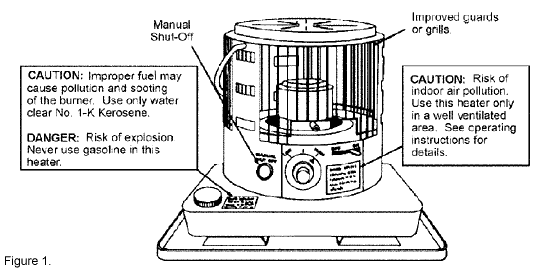Portable
kerosene heaters can supply homeowners with temporary heat
during a power outage or can be used to warm a cool room without
the expense of heating the entire house. Newer models are
manufactured with numerous safety features, but operator errors
such as using gasoline instead of kerosene, failure to provide
adequate ventilation, fuel spills, etc. have resulted in numerous
home fires. According to the National Fire Protection Association,
there is a "much higher" fatal fire risk associated with the
use of wood stoves, portable kerosene heaters and space heaters
as compared to central heating.
The
Fire Marshal Division of the Michigan State Police reports
there were 18 fires in Michigan during 1993 that were directly
attributed to kerosene heaters. One person was killed and
one injured in these 18 fires which caused an estimated $209,000
in damages.
The
following list will help reduce the risk of a fire from using
a portable kerosene heater:

- Use
only water-clear 1-K grade kerosene (see Figure 1). Never
use gasoline. Gasoline is not the same as kerosene. Even
small amounts of gasoline or other volatile fuels or solvents
mixed with kerosene can substantially increase the risk
of a fire or an explosion.
- Always
store kerosene in a container intended for kerosene, not
in a gasoline can or a can that has contained gasoline.
This helps avoid using contaminated fuel or the wrong fuel
by mistake. Kerosene containers are usually blue, gasoline
containers are red.
- When
purchasing kerosene at the pump, make sure to use the kerosene
pump, not the gasoline pump. Some service stations have
separate islands for kerosene. Some oil companies have also
established quality control programs to minimize the chances
of gasoline contamination of kerosene.
- 1-K
grade kerosene should be purchased from a dealer who can
certify that what is being sold is 1-K. State-operated and
private sector certification programs that ensure the quality
of kerosene are established in some states. Grades other
than 1-K can lead to a release of more pollutants in your
home, posing a possible health risk. Different grades of
kerosene can look the same so it important that the dealer
certify that the product sold is 1-K grade kerosene.
- Never
refuel the heater inside the home. Fill the tank outdoors,
away from combustible materials, and only after the heater
has been turned off and allowed to cool. Do not refuel the
heater when it is hot or in operation. Do not fill the fuel
tank above the "full" mark. The space above the "full" mark
is to allow the fuel to expand without causing leakage when
the heater is operated.
- In
case of flare-up or if uncontrolled flaming occurs, do not
attempt to move or carry the heater. This can make the fire
worse. If the heater is equipped with a manual shut-off
switch, activate the switch to turn off the heater. If this
does not extinguish the fire, leave the house immediately
and call the fire department. As an added reminder and precaution,
install at least one smoke detector near each sleeping are
or on each level of the house.
- Reduce
your exposure to indoor air pollutants by properly operating
and maintaining your portable kerosene heater. Although
portable kerosene heaters are very efficient in the burning
of fuel to produce heat, low levels of certain pollutants
such as carbon monoxide and nitrogen dioxide are produced.
Exposure to low levels of these pollutants may be harmful,
especially to individuals with chronic respiratory or circulatory
health problems.
- To
assure you and family members are not exposed to significant
levels of these pollutants, you should follow carefully
the following rules of safe operation:
- Operate
your heater in a room with a door open to the rest of
the house.
- If
you must operate your heater in a room with the door
closed to the rest of the house, open an outside window
approximately an inch to permit fresh air to effectively
dilute the pollutants below a level of concern.
- Always
operate your heater according to the manufacturer:s
instructions, making sure that the wick is set at the
proper level as instructed by the manufacturer.
- Keep
the wick in your heater clean and in good operating
condition by following the cleaning and maintenance
procedures recommended by the manufacturer.
- Keep
an outside window opened approximately an inch to ensure
adequate fresh air infiltration. This is important regardless
of whether you use a kerosene heater or some other conventional
method of heating. If your home is relatively new and
tight, or if it is older but has been winterized to
reduce air infiltration from the outside.
Reference:
Consumer Produce Safety Alert - 009403.
This
document is part of the Safety News Series, Agricultural Engineering
Department, Michigan State University Extension, East Lansing,
Michigan, 48824-1323. Publication date: December 1994.
Howard
J. Doss, Safety Leader, Agricultural Engineering Department,
Michigan State University, East Lansing, MI 48824-1323.
This
information is for educational purposes only. Reference to
commercial products or trade names does not imply endorsement
by the MSU Extension or bias against those not mentioned.
Disclaimer and Reproduction Information: Information in
NASD does not represent NIOSH policy. Information included in
NASD appears by permission of the author and/or copyright holder.
More
